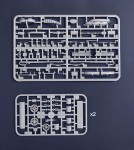1⁄72
Monday, July 15, 2019 - 08:47 PM UTC
New kit of a Type B Bus, which although being a civil vehicle, was extensively used during WWI.
In 1911,designer Frank Searle sketched out the design of a vehicle, which for many years was to become the "business card" of the city on the Thames. It was a twostory bus with stairs between the floors, which enabled a significant reduction in the size of the vehicle while still able to transport a large group of people.
From October 1914 to March 1915, 300 Type B buses were requisitioned, which were forced to exchange the streets of London for the shell-cratered terrain of France. Former civilian drivers from London were now obliged to become military drivers, and the work of the buses, which consisted in the rapid transfer of groups of soldiers to the front, was quite dangerous given the possibility of shelling by the enemy, and therefore the carriage of troops was carried out mainly at night.
Apart from the transport of personnel, they carried ammunition, food and medicine to the front line, and in the first postwar months after the signing of the Truce, they went back to permanent civilian work. In the spring of 1918, when Germany attempted a massive counteroffensive along the line of the Western Front, Type B buses, along with other types of omnibuses, carried at least 211.000 soldiers, with the total mileage covered by them amounting to over 1 million kilometers.
From October 1914 to March 1915, 300 Type B buses were requisitioned, which were forced to exchange the streets of London for the shell-cratered terrain of France. Former civilian drivers from London were now obliged to become military drivers, and the work of the buses, which consisted in the rapid transfer of groups of soldiers to the front, was quite dangerous given the possibility of shelling by the enemy, and therefore the carriage of troops was carried out mainly at night.
Apart from the transport of personnel, they carried ammunition, food and medicine to the front line, and in the first postwar months after the signing of the Truce, they went back to permanent civilian work. In the spring of 1918, when Germany attempted a massive counteroffensive along the line of the Western Front, Type B buses, along with other types of omnibuses, carried at least 211.000 soldiers, with the total mileage covered by them amounting to over 1 million kilometers.
Click Star to Rate
3 readers have rated this story.
THIS STORY HAS BEEN READ 4,673 TIMES.
| Roden Reviews | MORE |
| BL 8-Inch Howitzer by Rick Taylor | of 1 ratings, 100% found this helpful | |
| Holt 75 Tractor by Russ Bucy | of 1 ratings, 100% found this helpful | |
| BL 8-Inch Howitzer by Rick Taylor | |
| M43 3/4 Ton Ambulance by Kevin Brant | of 1 ratings, 100% found this helpful | |
| Holt 75 Artillery Tractor by Kevin Brant | |
| FLAK 88 VOMAG by Is a secret | of 1 ratings, 100% found this helpful | |
| Roden KrAZ 255B by Russ Amott | |
| Ludewig by Russ Amott | |
| Soviet Medium Truck KrAZ-214B by Gino P. Quintiliani | of 3 ratings, 100% found this helpful | |
| Opel Blitz omnibus W39 late by Russ Amott | of 3 ratings, 67% found this helpful | |
| sd.kfz 4/1 (8cm) by Russ Amott | of 2 ratings, 100% found this helpful | |
| Roden Vielfachwerfer by Matthew Lenton | of 5 ratings, 100% found this helpful | |
| Opel 3.6-47 Stabswagen by Russ Amott | of 8 ratings, 88% found this helpful | |
| Munitionskraftwagen Sd.Kfz.4 by Russ Amott | of 4 ratings, 100% found this helpful | |
| Opel 3.6-47 Omnibus by Russ Amott | of 4 ratings, 100% found this helpful | |












Comments